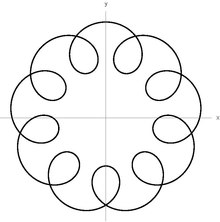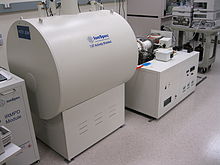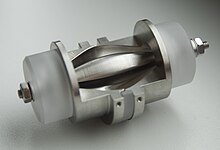Ion trap
This article has multiple issues. Please help improve it or discuss these issues on the talk page. (Learn how and when to remove these messages)
|

An ion trap is a combination of electric and/or magnetic fields used to capture charged particles — known as ions — often in a system isolated from an external environment. Atomic and molecular ion traps have a number of applications in physics and chemistry such as precision mass spectrometry, improved atomic frequency standards, and quantum computing.[1] In comparison to neutral atom traps, ion traps have deeper trapping potentials (up to several electronvolts) that do not depend on the internal electronic structure of a trapped ion. This makes ion traps more suitable for the study of light interactions with single atomic systems. The two most popular types of ion traps are the Penning trap, which forms a potential via a combination of static electric and magnetic fields, and the Paul trap which forms a potential via a combination of static and oscillating electric fields.[2]
Penning traps can be used for precise magnetic measurements in spectroscopy. Studies of quantum state manipulation most often use the Paul trap. This may lead to a trapped ion quantum computer[3] and has already been used to create the world's most accurate atomic clocks.[4][5] Electron guns (a device emitting high-speed electrons, used in CRTs) can use an ion trap to prevent degradation of the cathode by positive ions.
History
[edit]The physical principles of ion traps were first explored by F. M. Penning (1894–1953), who observed that electrons released by the cathode of an ionization vacuum gauge follow a long cycloidal path to the anode in the presence of a sufficiently strong magnetic field.[6] A scheme for confining charged particles in three dimensions without the use of magnetic fields was developed by W. Paul based on his work with quadrupole mass spectrometers.
Ion traps were used in television receivers prior to the introduction of aluminized CRT faces around 1958, to protect the phosphor screen from ions.[7] The ion trap must be delicately adjusted for maximum brightness.[8][9]
Theory
[edit]
Any charged particle, such as an ion, feels a force from an electric or magnetic field. Ion traps work by using this force to confine ions in a small, isolated volume of space so that they can be studied or manipulated. Although any static (constant in time) electromagnetic field produces a force on an ion, it is not possible to confine an ion using only a static electric field. This is a consequence of Earnshaw's theorem. However, physicists have various ways of working around this theorem by using combinations of static magnetic and electric fields (as in a Penning trap) or by an oscillating electric field and a static electric field(Paul trap). Ion motion and confinement in the trap is generally divided into axial and radial components, which are typically addressed separately by different fields. In both Paul and Penning traps, axial ion motion is confined by a static electric field. Paul traps use an oscillating electric field to confine the ion radially and Penning traps generate radial confinement with a static magnetic field.
Paul Trap
[edit]A Paul trap that uses an oscillating quadrupole field to trap ions radially and a static potential to confine ions axially. The quadrupole field is realized by four parallel electrodes laying in the -axis positioned at the corners of a square in the -plane. Electrodes diagonally opposite each other are connected and an a.c. voltage is applied. Using Maxwell's equations, the electric field produced by this potential is electric field . Applying Newton's second law to an ion of charge and mass in this a.c. electric field, we can find the force on the ion using . We wind up with
- .
Assuming that the ion has zero initial velocity, two successive integrations give the velocity and displacement as
- ,
- ,
where is a constant of integration. Thus, the ion oscillates with angular frequency and amplitude proportional to the electric field strength and is confined radially.
Working specifically with a linear Paul trap, we can write more specific equations of motion. Along the -axis, an analysis of the radial symmetry yields a potential[10]
- .
The constants and are determined by boundary conditions on the electrodes and satisfies Laplace's equation . Assuming the length of the electrodes is much greater than their separation , it can be shown that
- .
Since the electric field is given by the gradient of the potential, we get that
- .
Defining , the equations of motion in the -plane are a simplified form of the Mathieu equation,
- .
Penning Trap
[edit]
A standard configuration for a Penning trap consists of a ring electrode and two end caps. A static voltage differential between the ring and end caps confines ions along the axial direction (between end caps). However, as expected from Earnshaw's theorem, the static electric potential is not sufficient to trap an ion in all three dimensions. To provide the radial confinement, a strong axial magnetic field is applied.
For a uniform electric field , the force accelerates a positively charged ion along the -axis. For a uniform magnetic field , the Lorentz force causes the ion to move in circular motion with cyclotron frequency
- .
Assuming an ion with zero initial velocity placed in a region with and , the equations of motion are
- ,
- ,
- .
The resulting motion is a combination of oscillatory motion around the -axis with frequency and a drift velocity in the -direction. The drift velocity is perpendicular to the direction of the electric field.
For the radial electric field produced by the electrodes in a Penning trap, the drift velocity will precess around the axial direction with some frequency , called the magnetron frequency. An ion will also have a third characteristic frequency between the two end cap electrodes. The frequencies usually have widely different values with .[11]
Ion trap mass spectrometers
[edit]
An ion trap mass spectrometer may incorporate a Penning trap (Fourier-transform ion cyclotron resonance),[12] Paul trap[13] or the Kingdon trap.[14] The Orbitrap, introduced in 2005, is based on the Kingdon trap.[15] Other types of mass spectrometers may also use a linear quadrupole ion trap as a selective mass filter.
Penning ion trap
[edit]
A Penning trap stores charged particles using a strong homogeneous axial magnetic field to confine particles radially and a quadrupole electric field to confine the particles axially.[16] Penning traps are well suited for measurements of the properties of ions and stable charged subatomic particles. Precision studies of the electron magnetic moment by Dehmelt and others are an important topic in modern physics.
Penning traps can be used in quantum computation and quantum information processing[17] and are used at CERN to store antimatter. Penning traps form the basis of Fourier-transform ion cyclotron resonance mass spectrometry for determining the mass-to-charge ratio of ions.[18]
The Penning Trap was invented by Frans Michel Penning and Hans Georg Dehmelt, who built the first trap in the 1950s.[19]
Paul ion trap
[edit]
A Paul trap is a type of quadrupole ion trap that uses static direct current (DC) and radio frequency (RF) oscillating electric fields to trap ions. Paul traps are commonly used as components of a mass spectrometer. The invention of the 3D quadrupole ion trap itself is attributed to Wolfgang Paul who shared the Nobel Prize in Physics in 1989 for this work.[20][21] The trap consists of two hyperbolic metal electrodes with their foci facing each other and a hyperbolic ring electrode halfway between the other two electrodes. Ions are trapped in the space between these three electrodes by the oscillating and static electric fields.
Kingdon trap and orbitrap
[edit]
A Kingdon trap consists of a thin central wire, an outer cylindrical electrode and isolated end cap electrodes at both ends. A static applied voltage results in a radial logarithmic potential between the electrodes.[14] In a Kingdon trap there is no potential minimum to store the ions; however, they are stored with a finite angular momentum about the central wire and the applied electric field in the device allows for the stability of the ion trajectories.[22] In 1981, Knight introduced a modified outer electrode that included an axial quadrupole term that confines the ions on the trap axis.[23] The dynamic Kingdon trap has an additional AC voltage that uses strong defocusing to permanently store charged particles.[24] The dynamic Kingdon trap does not require the trapped ions to have angular momentum with respect to the filament. An Orbitrap is a modified Kingdon trap that is used for mass spectrometry. Though the idea has been suggested and computer simulations performed[25] neither the Kingdon nor the Knight configurations were reported to produce mass spectra, as the simulations indicated mass resolving power would be problematic.
Trapped ion quantum computer
[edit]Some experimental work towards developing quantum computers use trapped ions. Units of quantum information called qubits are stored in stable electronic states of each ion, and quantum information can be processed and transferred through the collective quantized motion of the ions, interacting by the Coulomb force. Lasers are applied to induce coupling between the qubit states (for single qubit operations) or between the internal qubit states and external motional states (for entanglement between qubits).
See also
[edit]References
[edit]- ^ H. Häffner; C. F. Roos; R. Blatt (2008). "Quantum computing with trapped ions". Physics Reports. 469 (4): 155–203. arXiv:0809.4368. Bibcode:2008PhR...469..155H. doi:10.1016/j.physrep.2008.09.003. S2CID 15918021.
- ^ D. Leibfried; R. Blatt; C. Monroe; D. Wineland (2003). "Quantum dynamics of single trapped ions". Reviews of Modern Physics. 75 (1): 281–324. Bibcode:2003RvMP...75..281L. doi:10.1103/RevModPhys.75.281.
- ^ R. Blatt; D. J. Wineland (2008). "Entangled states of trapped atomic ions" (PDF). Nature. 453 (7198): 1008–1014. Bibcode:2008Natur.453.1008B. doi:10.1038/nature07125. PMID 18563151. S2CID 316118.
- ^ T. Rosenband; D. B. Hume; P. O. Schmidt; C. W. Chou; A. Brusch; L. Lorini; W. H. Oskay; R. E. Drullinger; T. M. Fortier; J. E. Stalnaker; S. A. Diddams; W. C. Swann; N. R. Newbury; W. M. Itano; D. J. Wineland; J. C. Bergquist (2008). "Frequency Ratio of Al+ and Hg+ Single-Ion Optical Clocks; Metrology at the 17th Decimal Place" (PDF). Science. 319 (5871): 1808–1812. Bibcode:2008Sci...319.1808R. doi:10.1126/science.1154622. PMID 18323415. S2CID 206511320.
- ^ S. M. Brewer; J.-S. Chen; A. M. Hankin; E. R. Clements; C. W. Chou; D. J. Wineland; D. B. Hume; D. R. Leibrandt (2019). "Al+ Quantum-Logic Clock with a Systematic Uncertainty below 10^-18". Phys. Rev. Lett. 123 (3): 033201. arXiv:1902.07694. Bibcode:2019PhRvL.123c3201B. doi:10.1103/PhysRevLett.123.033201. PMID 31386450. S2CID 119075546.
- ^ F.M. Penning (1936). "Die glimmentladung bei niedrigem druck zwischen koaxialen zylindern in einem axialen magnetfeld". Physica. 3 (9): 873. doi:10.1016/S0031-8914(36)80313-9.
- ^ Hartson, Ted (2004). "How the World Changed Television" (PDF). Retrieved 2008-10-13.
- ^ Magnet for cathode-ray tube ion traps
- ^ Ion Trap for a Cathode Ray Tube
- ^ Foot, Christopher (2005). Atomic Physics. New York: Oxford University Press. p. 259. ISBN 0198506961.
- ^ Foot, Christopher (2005). Atomic Physics. New York: Oxford University Press. p. 273. ISBN 0198506961.
- ^ Blaum, Klaus (2006). "High-accuracy mass spectrometry with stored ions". Physics Reports. 425 (1): 1–78. Bibcode:2006PhR...425....1B. doi:10.1016/j.physrep.2005.10.011.
- ^ Douglas, DJ; Frank, AJ; Mao, DM (2005). "Linear ion traps in mass spectrometry". Mass Spectrometry Reviews. 24 (1): 1–29. Bibcode:2005MSRv...24....1D. doi:10.1002/mas.20004. PMID 15389865.
- ^ a b Kingdon KH (1923). "A Method for the Neutralization of Electron Space Charge by Positive Ionization at Very Low Gas Pressures". Physical Review. 21 (4): 408–418. Bibcode:1923PhRv...21..408K. doi:10.1103/PhysRev.21.408.
- ^ Hu, QZ; Noll, RJ; Li, HY; Makarov, A; Hardman, M; Cooks, RG (2005). "The Orbitrap: a new mass spectrometer". Journal of Mass Spectrometry. 40 (4): 430–443. Bibcode:2005JMSp...40..430H. doi:10.1002/jms.856. PMID 15838939.
- ^ Brown, L.S.; Gabrielse, G. (1986). "Geonium theory: Physics of a single electron or ion in a Penning trap" (PDF). Reviews of Modern Physics. 58 (1): 233–311. Bibcode:1986RvMP...58..233B. doi:10.1103/RevModPhys.58.233. Archived from the original (PDF) on 2017-03-13. Retrieved 2014-08-09.
- ^ Häffner, Hartmut, Christian F. Roos, and Rainer Blatt. "Quantum computing with trapped ions." Physics Reports 469.4 (2008): 155–203.
- ^ Marshall, A. G.; Hendrickson, C. L.; Jackson, G. S. (1998). "Fourier transform ion cyclotron resonance mass spectrometry: A primer". Mass Spectrometry Reviews. 17 (1): 1–35. doi:10.1002/(SICI)1098-2787(1998)17:1<1::AID-MAS1>3.0.CO;2-K. PMID 9768511.
- ^ "Hans G. Dehmelt – Biographical". Nobel Prize. 1989. Retrieved June 1, 2014.
- ^ Paul W., Steinwedel H. (1953). "Ein neues Massenspektrometer ohne Magnetfeld". RZeitschrift für Naturforschung A 8 (7): 448–450
- ^ DE 944900 "Verfahren zur Trennung bzw. zum getrennten Nachweis von Ionen verschiedener spezifischer Ladung", W. Paul and H. Steinwedel, filed on December 24, 1953, priority December 23, 1953
- ^ Major, Fouad G. (2005). Charged particle traps: physics and techniques of charged particle field. Springer. ISBN 3-540-22043-7.
- ^ Knight, R. D. (1981). "Storage of ions from laser-produced plasmas". Applied Physics Letters. 38 (4): 221–223. Bibcode:1981ApPhL..38..221K. doi:10.1063/1.92315.
- ^ Blümel, R. (1995). "Dynamic Kingdon trap". Physical Review A. 51 (1): R30–R33. Bibcode:1995PhRvA..51...30B. doi:10.1103/PhysRevA.51.R30. PMID 9911663.
- ^ Oksman, Pentti (1995-01-10). "A Fourier-transform time-of-flight mass spectrometer. A SIMION calculation approach". International Journal of Mass Spectrometry and Ion Processes. 141 (1): 67–76. Bibcode:1995IJMSI.141...67O. doi:10.1016/0168-1176(94)04086-M.
External links
[edit]- VIAS Science Cartoons A cranky view of an ion trap...
- Paul trap




































